How To Create A Winning Video Marketing Strategy For Your Clients

Nov 08, 2023
- Content Creation
- Daniel Trick

If you run an agency, you need to be offering video marketing services.
Video is one of the best ways to engage audiences and market a business.
A recent study found that 91% of consumers want to see more video content from brands. And 92% of marketers say video content offers good ROI.
In this guide, we’ll break down what goes into a successful video marketing strategy. You’ll learn how to create video content that helps your clients grow.
We’ll cover:
- What video marketing involves
- How to identify and address customer needs with video content
- Choosing the right video distribution channels
- The types of marketing videos you can create
- How to develop a complete video marketing strategy
What Is Video Marketing
Video marketing is the use of video content to promote a business and its products and services. It’s a powerful way to engage customers and explain complex topics in a format that’s easy to digest and share.

You can use video marketing to expand your reach and engage audiences throughout each stage of the buyer’s journey.
Video marketing is the future of digital marketing.
Use video content to:
– tell your brand’s story
– engage with your audience
– showcase your product’s benefits— UsmanSheikh (@UsmanHSheikh) July 29, 2023
Benefits of Video Marketing
A video marketing strategy can help businesses in many ways.
Here are the key benefits:
Increase Engagement and Awareness
A video captures attention faster than text.
You can get more people to stay longer on a landing page, engage with a post on social media, and click your emails. A recent study by Campaign Monitor found that video boosts email click-through rates by 65%.
Video is a great way to stand out on social media feeds and capture attention.
A Wave survey found that increasing brand awareness is the number one purpose for using video content:

Build Trust
Video is a great way to build trust. It can get potential customers to feel more connected to a business.
You can create video testimonials, introduce your team, and show viewers what goes on behind the scenes.
This makes the business seem more real and trustworthy.
That trust can translate into more sales. In a survey by Animoto, 95% of marketers said they had attracted a new client due to a video on social media.
Make More Sales
In Wyzowl’s latest Video Survey, 87% of businesses said that video marketing has helped them increase sales.
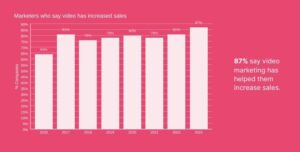
Video is one of the best ways to communicate the value of a product. You can show how the product works, highlight the key features, and address common customer concerns.
It’s a super-effective format for getting people to overcome barriers to making a purchase.
Identifying Target Audience
Ready to create a video marketing strategy?
The first step is to determine who you are creating your videos for. Who do you want to reach with your video content?
This will depend on your client’s products and services. You might have a specific target audience for a consumer product or multiple decision-makers for a B2B offering.
Ask your client what their ideal customer looks like. Consider factors like:
- Age
- Location
- Income level
- Occupation
This will help you determine the best types of video content to create and which platforms to use in your strategy.
Understanding Your Clients’ Customers
Once you know your target audience, you can start narrowing in on the types of video content that will resonate with them. It’s about understanding the audiences’ needs, preferences, and pain points.
This will help you create marketing videos that are helpful and interesting for the viewers.
For example, you can create how-to videos that show people how to accomplish a task using your client’s product. You could create success stories for more complex services to inspire and motivate your audience.
Crafting Your Messaging & Branding
Video is part of your overall content marketing strategy. It should reflect your client’s existing branding and messaging.
It’s also important to establish a recognizable visual identity. Use consistent brand colors for graphics, text, and intros and outros.
You can make slight changes depending on the video’s objective, but it should fit within the overall branding.
Researching the Competition
Seeing how similar businesses use video content can help you plan your video marketing strategy.
Look for videos from businesses offering similar products or services to your client.
You check their social media profiles and websites. It’s also a good idea to analyze YouTube.
Search for keywords related to your niche and take note of channels that consistently appear in search results.
What types of videos are they producing?
What topics do they cover most often?
One of the benefits of doing competitive research on YouTube is that you can see the view counts and user engagement.
Visit the profile of a competitor and click on the ‘Popular’ tab:
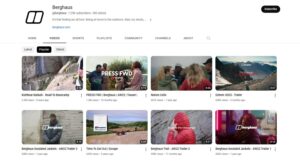
This will sort the results by view count.
Look at the length, style, and tone of the top-performing videos. This will show you the topics and types of video content that resonate with your target audience.
It will also give you some insights into how the competitor is using YouTube SEO to get more visibility.
Choosing Social Media Platforms
Picking the right social media platforms is key to your video marketing strategy. You need to know where your client’s customers spend their time online.
YouTube is the most popular platform for marketers when sharing video content:
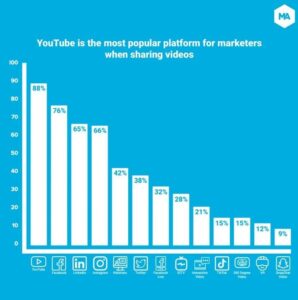
But the right platform depends on your client and their audience.
Think about the age of your ideal viewer. Some platforms are more popular with certain age groups. For example, TikTok is popular with younger demographics, while older generations are more likely to use Facebook.
It’s also important to consider the type of videos you plan to create. More in-depth, longer content is typically more suited for YouTube. Short, fun videos are better on TikTok and Snapchat.
You can analyze your competitor’s social media presence to see which platforms they’re focusing on and which provide the most engagement.
Popular Social Platforms For Video Marketing
Here’s a breakdown of your options:
YouTube
A platform made just for sharing and watching videos. You can create your own channel, use playlists to organize content, and analyze video performance using YouTube analytics.
YouTube is best for detailed product demos, how-to guides, and long-form content.
Facebook is still the world’s most popular social media platform. It offers a range of formats to distribute video content. You can create video posts, video ads, and Facebook stories.
It’s a great platform to display video testimonials and product videos. You can also use targeted advertising to push your best-performing video content.
Instagram is a visual platform that is great for video content. On average, organic video posts generate 40% more comments and likes than organic image posts on the platform.
You can create short stories, use IGTV for longer videos, and Reels for quick, engaging video content. It’s best for showcasing products, brand stories, and behind-the-scenes content.
TikTok
TikTok is known for its short, catchy video clips. According to Wired, the optimal video length for engagement is 21 to 34 seconds.
You can create branded filters, duets with other users, and capitalize on trending challenges. It’s best for promoting products, showcasing company culture, and tapping into a younger demographic.
LinkedIn is a professional network. It’s an excellent social media platform for B2B marketing. You can reach decision-makers, share company updates, and demonstrate your expertise with video content.
It’s best for sharing industry insights, thought leadership content, and customer testimonials.
Understanding Platforms Features and Limitations
Choosing the right platforms isn’t just about knowing where your audience is. It’s also about understanding the features and limitations.
Each platform has its own specifications for video content.
For example, YouTube allows unverified accounts to upload videos up to 15 minutes long. The platform also provides detailed analytics to help you understand viewer behavior and preferences.
Platforms like Instagram and TikTok have shorter video specifications.
You’ll need to check the requirements of the platform you plan to use to make sure it’s a good fit for your video content.
Creating Types of Videos for Different Goals
There are lots of different types of content you can create as part of your video marketing campaign.
In a recent survey, social media and explainer videos were the most popular video types created by marketers:

Before making any videos, think about what you want to achieve. You can use different types of videos to help with different goals.
Explainer Videos
Explainer videos are short educational videos that tell people about a product or service. They help people understand what something is, how it works, and why they might need it.
Here’s an example from Segment:
These videos usually have a clear and simple message. They often show someone using a product or animations to explain a more complex service.
Explainer videos are great for educating prospects about a problem and proposing a solution. Instead of reading a lot of information, they can watch a short video.
Check out our explainer video page to see how FATJOE can help you create an animated explainer video in as little as 7 days.
Testimonial Videos
Customer testimonial videos are a powerful form of social proof. Over 66% of people are more likely to make a purchase after watching a testimonial video.
You can create a video of your client’s customers talking about how a product or service helped them achieve their goals.
Here’s an example from FreshBooks:
Animated Videos
Animated videos are a great way to tell a story, explain an idea, or show how something works. You can simplify concepts and visualize scenarios.
Here’s an example from Slack:
Animated videos are one of the easiest ways to get started with video marketing.
With the FATJOE Blog 2 Video service, you just submit the URL of your blog post, and we’ll create a professional, branded video. You can start building out your client’s video marketing strategy in just a few minutes.
Social Videos
These short, dynamic videos are a great way to enhance your social media marketing strategy. You can promote a new product, tell your brand story, or provide a look behind the scenes to build trust and credibility.
Social videos can also work well as paid ads.
Here’s an example from ClickUp:
If you want to make a video ad for social media, FATJOE can help. Send us your brief, and we’ll create a dynamic video ad in as little as 7 days.
And if you’re not 100% happy, we’ll refund your money. Our service is a risk-free way to get started with video ads.
Developing a Video Strategy and Plan
Once you choose the type of video you want to create, the next step is to make a strategy and plan. Here’s how to do it:
Establishing Objectives & KPIs
First, you need to establish what you want to achieve. And you need to know how you will measure the performance of your video marketing efforts.
Objectives and KPIs.
Objectives are the big goals. For example, you might want to increase awareness of a new product or drive traffic to a landing page.
KPIs (Key Performance Indicators) are the metrics you use to see if you meet your objectives.
If you want to get more people to know about a product, you could use video views and engagement metrics as KPIs.
In a recent HubSpot survey, marketers ranked engagement and conversion rate as the two most important metrics for measuring video performance:
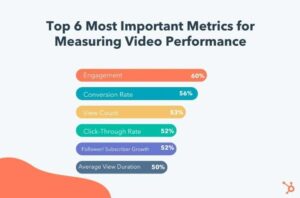
The right KPIs for your video marketing strategy will depend on your objectives.
Decide on a Brand Tone With the Client
Next, you want to decide on a brand tone with your client. A consistent tone will make your video content more memorable.
Ask your client how they want their business to sound. Do they want to be seen as serious experts? Or as a helpful friend?
Once you’ve decided on a tone, use it in all of the client’s videos. This will contribute to a cohesive brand experience.
Produce The Video
It’s time to implement the plan and create your video content.
Start by writing a script for your video. A script details everything that will happen in the video – from spoken words to actions. It’s a roadmap for video production.
Make sure the client approves your script before you start filming.
Check out our video script guide to learn the essential elements you should include in your script and how to write it.
On the day of filming, make sure you get multiple takes. Recording the same scene several times will give you more options during editing.
Filming tip I’ve been using recently:
When you mess up a line, don’t try again at the point where you messed up. You’ll put too much energy into the first word and the transition will sound awkward.
Instead, start again a few words back. Then the cut will sound natural.
— Thomas Frank (@TomFrankly) August 17, 2018
During the editing stage, arrange your clips in the right order based on the script and select the best takes for each shot.
Put together a rough edit and show it to your client to get feedback. If the client is happy with the edit, add title inserts, music, and special effects to enhance the video.
Outsourcing
Writing and shooting a marketing video is hard. It takes a lot of time. And if it’s not something you’ve done before, you’ll naturally make mistakes.
Outsourcing is the fastest and easiest way to add video marketing to your service list without stretching your in-house resources. You can get a better final product and save yourself a bunch of time and effort.
In a 2022 survey, video design and animation was the second most popular content task outsourced by marketing professionals:

You can tap into specialized talent and equipment that’s expensive and impractical to maintain In-house.
Outsourcing can also help you deliver faster turnaround times. It allows you to take on more projects and meet client demands faster. You can get an external partner to handle the production while you focus on strategy.
Outreach
After you’ve made a video, you want as many people as possible to see it. That’s where outreach and distribution come in.
A recent survey revealed the most popular distribution channels for video content:
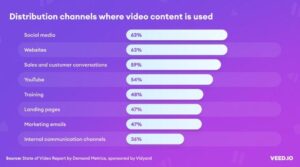
You can post your video on social media, share it with your email list, and add it to the client’s website.
Make sure you use structured data and other on-page SEO (search engine optimization) tactics to make the video page more discoverable.
Video SEO – How to optimize embedded videos for search:
* Choose an optimized video hosting platform
* Add descriptive text to the video and page
* Make video embeds prominent
* Include VideoObject Schema
* Make videos discoverableBy @henshaw 👏🤩 pic.twitter.com/WbsJMDv9yE
— Aleyda Solis 🇺🇦 (@aleyda) March 29, 2023
You should also consider running paid ads to promote your video on relevant platforms. See which of your videos generate engagement organically and boost the top-performing content with paid ads.
Video is also super-effective for link building.
Reach out to relevant, high-quality websites and ask them to share your video with a link to your website.
Create a Video Marketing Strategy for Your Clients
A good video marketing strategy is much more than just creating content that looks good. It’s about understanding the client’s brand, knowing their audience, and leveraging the right platforms.
With clear objectives, you can create compelling videos that resonate and drive results throughout the marketing funnel.
Video isn’t just a nice-to-have – it’s a necessity for modern digital marketing.
Become a Pro at SEO
Join 65,000 others and learn the secrets to SEO success with our weekly blog posts.
